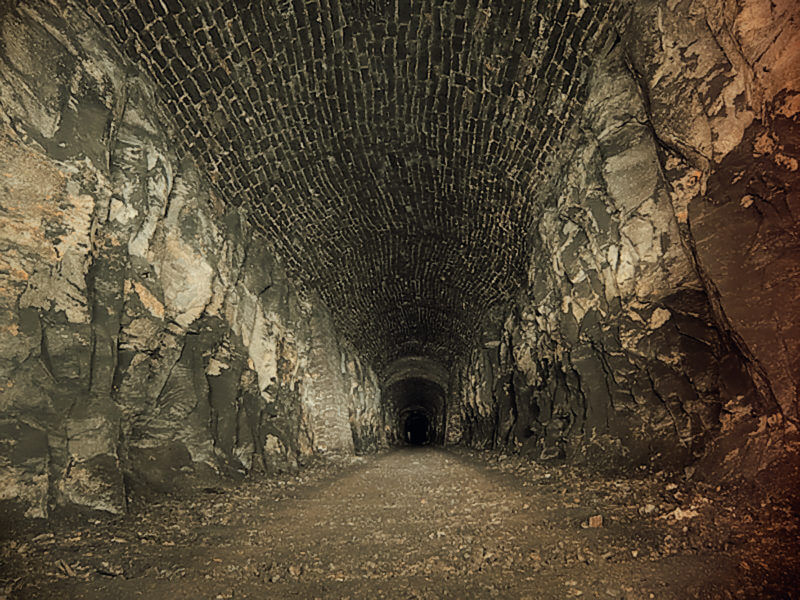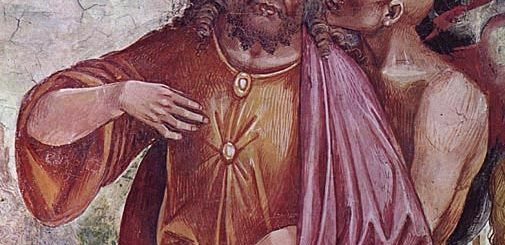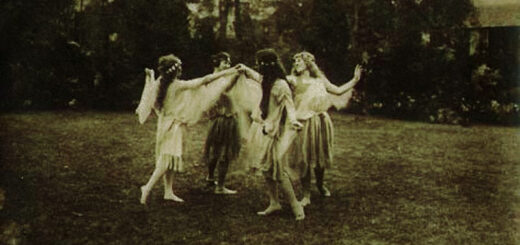Mountain spirits
Mountain spirit (lat.: daemon subterraneus, “underground demon”; besides also daemon metallicus “mine demon”) is the generic term for different mythical creatures, which are to be found in mines or in the mountains. Especially in German speaking countries and regions they play and important role in folk lore, mythology or magic, but mountain spirits exist all over the world. Well-known examples are the Bergmönch (mountain monk), the Bergteufel (mountain devil) and the goblin-like Bergmännchen (small mountain men) or Trolle (trolls).

Especially in German speaking areas of Europe, there is a centuries old belief in mountain spirits
Later, the term was extended in a broader sense to include forest and mountain spirits such as Rübezahl (Riesengebirge region). Other common names for mountain spirits are Knappenmandl, Grubenmännlein, Lötterl (Slovenia). Names for individual mountain spirits are Nickel, Skarbnik (treasure keeper, Upper Silesia), Gübich (Harz), Gangerl (area around Budweis).
Precursors
The term “Bergmännlein” was first mentioned in 1487 as the name of a mine in Schneeberg. At about the same time, a woodcut illustrating the oldest poem on mining in the Erzgebirge region, Judicium Jovis, by the humanist Paulus Niavis, depicts three naked, childlike creatures, without clear sexual characteristics, who are interpreted as protective spirits of mining. Possibly this kind of representation is based on the ancient Penates who watched over the pantry and the supplies of a household. Elsewhere, Niavis also reports that the miners in Schneeberg knew of dangerous Unter-Tage-Dämonen (underground demons) “that do violence to people”. In a Prague miniature from 1525, about the granting of the right to mint coins to the miners of Kuttenberg by Wenceslas II, a small, naked figure also crouches at the feet of the king, which stretches out a pit light to greet the miners.

Naked mountain spirit (Bergmännchen) at the feet of King Wenzels II, who just installed the Kuttenberger Bergordnung in 1280
Agricolas’ systematics of the mountain spirits

Carl Spitzweg (1808-1885) – Bergmännchen
In his scientific writings about mining, Bermannus (1530), De animantibus subterraneis (1549) and De re metallica (1556), Georgius Agricola tried, among other things, to bring the traditions of the miners known to him into line with the views of medieval demonologists such as Michael Psellos and Johannes Trithemius. Psellos, for example, divided demons into six classes, of which he considered the fifth, the “underground class”, to be among the most vicious and dangerous, along with the “light-haters”, because they were equipped with a solid body. Agricola countered that there were also harmless and good-natured mountain spirits besides such evil spirits. He called these two kinds of mountain spirits (and the glossary of De animantibus):
– daemon subterraneus truculentus (Latin: dark, coarse, wild): “Bergteufel (mountain devil)”.
– daemon subterraneus mitis (Latin: mild, peaceful): „Bergmennel“, „Kobel“, and „Guttel“.
Contrary to the theologians of his time, he counted these spirits also among living beings and not among purely spiritual beings.
As an example of a “Bergteufel”, Agricola mentions here for the first time a ghost with wild eyes and a long neck (like a horse), who is said to have killed twelve workers in Annaberg with his poisonous breath, whereupon the mine, despite its high silver content, was abandoned. In the early German translations, however, there is direct reference to a “horse” with a long neck and wild eyes, and in this form this (nameless) spirit has also entered the saga.
Another example is a ghost in a black frock who is said to have lifted up a worker in the St. Georg mine on the Schneeberg and transferred him to a silver-rich cave, “not without doing him evil”. (In more recent transmissions, however, there is only talk of a suspended tool which the spirit “not without physical exertion” brought up into a higher distance.) Even if Agricola does not call him that, this spirit is obviously the “boshaften Bergmönch” (malicious Miner Monk) who later found his way into the miner’s legends, especially in the Harz Mountains, the Erzgebirge in Saxony and Transylvania.
Agricola confronts these dangerous, vicious loners with the sociable “miners”. They show the characteristic behaviour of goblins: they giggle cheerfully and make themselves noticed by noises (knocking etc.), or stone throws, run here and there and imitate working people. Mostly they are invisible. Otherwise, they appear in the form of old men, measuring only three feet and wearing the typical miners’ work clothes with hooded coats and ass leather. This appearance became canonical for dwarfes from now on. Even if they tease the miners sometimes, so they harm them only rarely (only after they were insulted by laughter or insults). The miners have nothing against the presence of the Bergmännchen. On the contrary, they are considered a good omen for rich finds (hence the name Guttel from “Gut”, “good”). Agricola itself compares it with the above-ground house-spirits, that help the people in the household or with the cattle-feeding (similarly like Wichtel or Heinzelmännchen), as well as with the Scandinavian trolls, however also the latter in a harmless, “domesticated” form, Agricola with the above-ground house-spirits.
Christian demonization of mountain spirits
This clear division into friendly and hostile mountain spirits, has already been partly blurred again by Agricola’s contemporaries. Even the translators of his Bermannus called the misanthropic mountain spirits “Bergmännel” again. In his Cosmographia, only Sebastian Münster maintained the strict separation between “Klein Teüfelin” and “Bergmenlin”.

Haunted part of a mine
In the religiously heated climate of the Reformation and Counter-Reformation, the diabolisation of the miner’s spirit was constantly advancing: Martin Luther attributed the dread of the miner’s monk (Bergmönch) in particular to Satan’s direct influence, who also tried to bring the miners to their doom through lies and deception. The reformer and preacher Johannes Mathesius still knows the terms “Cobelt” and “Gütlein”, but their philanthropic nature seems forgotten. All of them are mere ghosts. The “Bergteufel” is surrounded by numerous “Bergteufelein” (small mountain devils), and just like these the “Bergmennel” have nothing else in mind but to frighten the miner and plunge him to his death. Also in the work of the Catholic Olaus Magnus the mountain spirit is depicted throughout in the iconography of the devil at that time (even if he “helps” with the work): with big ears, or horns, beak-like muzzles, claw hands and birds of prey feet.

Paracelsus
Paracelsus created new impulses, but also confusion, by placing the mountain spirits in the framework of the four-element doctrine and declaring them elemental spirits. He described the mountain spirits as “Pygmäen (pygmies)”, who, apart from their small stature, have almost nothing to do with the pygmies of ancient tradition, or, with a Greek foreign word of unclear meaning, as gnomes. Unlike Agricola, Paracelsus by no means attributes a solid body to the earth spirits, but considers them, on the contrary, to be extremely subtle and almost bodiless, since they can move through the densest of all elements, earth. Similar to Salamanders (Fire-Elementals), they consist of a fiery substance of light. But since they can also move effortlessly through less dense elements, like the Undines (Water-Elementals) they sometimes come into contact with people. Then they appear in the form of Irrlichtern (night wisps), ghosts or traditionally as helpful little males. Like the other elemental spirits, the gnomes have no soul. They can only achieve this by marrying a human being. The possible descendants of gnomes and humans are dwarfes.
Mountain spirits in the saga

Rübezahl, Moritz von Schwind, 1859
In addition, such ideas from the writings of humanistic Renaissance scholars returned to popular narratives. There, the individual elements were combined with each other in a variety of new ways and from there they reached the collections of sagas of the 18th and 19th centuries.
The solitary Berggeist (mountain-spirit) assumes more and more trains of the sociable Bergmännchen. Like these, it often appears now in the shape of a little old man in miner’s clothes. Likewise, it can lead the miners to new discovery-places and helps them occasionally in person with the mining of the ores. Sometimes, the miners bring it sacrifices (daily food and a chandelier, a red skirt once a year). If it is not fulfilled, the ore runs dry, or worse, the tardy one is killed by the mountain ghost. In general, the mountain spirit rewards diligence and honesty, but punishes greed and breaking one’s word. Like the gnomes of Paracelsus he can walk through the rock, often appearing also above ground, at the shafts, in the mountains and in the forest (where still unknown rich ore veins can be found). Mostly the mountain ghost is regarded as male, but sometimes also as female, as a beautiful fairy or white woman, who sometimes falls in love with a miner. Rarely the mountain ghost is a wild man (founding legend of Wildermann in the Harz Mountains), or a water sprite (in a lake near Erzberg).
Also the goblin-like Bergmännchen appear more and more as fairy-like beings: their clothes are (for miners) either strikingly “colorless” (white, gray, silver), or strikingly colorful (red, green). Their festivities and dances do not only take place in underground caves and palaces, but also on meadows in the moonlight. Occasionally (for example, in Banská Štiavnica) the mountain-spirits appear even in shape of barefoot dancing girls. In stories about a war between different dwarf peoples, however, the dualism between “Bergteufelein” (litte mountain devils) and “Bergmännlein” (little mountain men) sometimes still shines through. In addition, the mountain spirits also appear as small animals, e.g. rats (which run out of mountain crevices), or as black birds, flies and hornets, etc.
The Bergmönch, an evil mountain spirit
The Bergmönch (mountain-monk) in particular became an extremely contradictory figure: instead of appearing in the form of a monk, he also appears as a giant with a hood (with sparkling eyes, as big as carriage wheels), in the form of a climber or mountain master (with a silver pit light) or even more frequently as a juror. In fact, in some legends, he is considered to be the ghost of a dead miner who could not part from his beloved work and now has to work in the tunnels and pits forever. He is still dangerous, like a mountain devil, and kills with his poison breath the miners who complain about him. The apparition makes galleries collapse or causes water infiltrations and firedamp. On the other hand, the miners he throws into the shafts or wheelworks are usually unjust guards or greedy liars. Poor miners, on the other hand, he presents with rich ore and money. He brings food to the buried and renews the candles in their lamps. For his contribution to the miners work he demands half of his wages. If the miner really wants to share honestly with him, he also gives him the other half.
The mountain spirit as treasure keeper

Mountain spirits are often gnomish like dwarfs
An important function of the mountain spirit is that of the treasure keeper. In underground caves and palaces he guards immeasurable treasures of precious metals and gems. These guards are often demonic beings, such as black dogs, snakes, basilisks, dragons, or the ghosts of wicked and damned miners. Sometimes the treasurer is an executioner, with a red cloak and a bare sword, who only kills the cowards who retreat before him, but let the brave pass. Even the devil in the flesh sometimes acts as treasure keeper. The Upper Silesian Skarbnik has many similarities, both with the Bergmönch and with Rübezahl, but tends to behave even more viciously. It usually appears in the form of a miner, but has pitch-black or red-hot eyes. Just by looking at him he can make an intruder incurably ill. While the miners generally depend on the goodwill of the treasurers to make rich finds, the “Walen” (ore seekers) in the legends often have power over the treasurers. Occasionally, however, it is also the “Mistress of the Mountain” who rules over the other mountain spirits, who guards treasures and can allocate them as she pleases (e.g. to her lover), or let them disappear again.
Knockers

Leprechaun
Knockers, also known as Knacker, Bwca (Welsh), Bucca (Cornish), the Kloker (Kent) and the English and Scottish Brownie. The Cornish described the creature as a little person two feet tall, with a big head, long arms, wrinkled face, and white whiskers. It wears a tiny version of standard miner’s garb and commits random mischief, such as stealing miners’ unattended tools and food. Tommyknockers (USA), is the name of goblins or mountain spirits in Wales or Cornwall. The name derives from their habit of knocking on the walls of mines. Also the Púcas, which are very similar to the Knockers in their underground way of life, are called Bwca or Bucca in Wales and Cornwall.
The Knockers are the equivalent to the Irish Leprechauns and Cluricauns as well as to the English or Scottish Brownies. The Knockers are up to two meters tall, live underground and are usually dressed like miners. In the mines they muck around with the miners, steal their tools and food or frighten them. Their knocking is interpreted as hammering to make the tunnels collapse. The Cornish miners, however, consider Buccas to be good spirits, who once were miners themselves, then crashed and now warn their successors of the danger. In Cornwall’s many tin mines, there have been many severe tunnel collapses, and so the miners have always left a few bites of their meals in the tunnel as a thank you for this warning.
In the 1820s, immigrant Welsh and Cornish miners brought tales of the tommyknockers and their theft of unwatched items and warning knocks to western Pennsylvania, when they gravitated there to work in the mines. Cornish miners, much sought after in the years following the gold and silver rushes, brought them to Colorado, Nevada, and California. When asked if they had relatives who would come to work the mines, the Cornish miners always said something along the lines of “Well, me cousin Jack over in Cornwall wouldst come, could ye pay ’is boat ride”, and so came to be called Cousin Jacks. The Cousin Jacks, as notorious for losing tools as they were for diving out of shafts just before they collapsed, attributed this to their diminutive friends and refused to enter new mines until assured by the management that the knockers were already on duty. Even non-Cornish miners, who worked deep in the earth where the noisy support timbers creaked and groaned, came to believe in the Tommyknockers. The American interpretation of knockers seemed to be more ghostly than elvish.
Belief in the knockers in America remained well into the 20th century. When one large mine closed in 1956 and the owners sealed the entrance, fourth, fifth, and sixth generation Cousin Jacks circulated a petition calling on the mineowners to set the knockers free so that they could move on to other mines. The owners complied. Belief among Nevadan miners persisted among its miners as late as the 1930s
Yamatsumi
Ōyamatsumi (jap. オオヤマツミ (Kojiki: 大山津見神; Nihonshoki: 大山祇〔神〕); translated by Karl Florenz as “Great Mountain Lord”) is the highest mountain kami of the Shintō, which originated when Izanagi and Izanami gave birth to the land masses after the rivers and lakes. According to an alternative version of Nihonshoki, it originated from one of the parts into which Izanagi smashed the fire kami Kagutsuchi.
Yamatsumi is also a general name component of mountain spirits, so that in the people’s Shintō as well as in other popular beliefs in Japan often mountain deities (yama no kami) are worshipped under the name Ōyamatsumi, which are not identical with Ōyamatsumi from the classical myths.
You may also like to read:
Water-Spirits of Eastern Europe
Poltergeist
Witches ointment
Why did Witches Want to Ride their Broomsticks?
The incubus or succubus – nightmare or astral sex date?
Hecate – The Calling of the Crossroad Goddess
The Ancient Witch-Cult of The Basques
Walpurgis Night
Stefan Eggeler: Walpurgis Night witches, Kokain (Cocaine) and other illustrations
Witchcraft paintings – Dutch 17th century
Rosaleen Norton, Daughter of Pan
Mysteries of the Ancient Oaks
Black Cat Superstitions
The Mystical Mandrake
Little Secrets of the Poppy
Datura stramonium or jimson weed or zombi-cucumber
Wild Man or Woodwose
Sprite
Claude Gillot’s witches’ sabbat drawings






